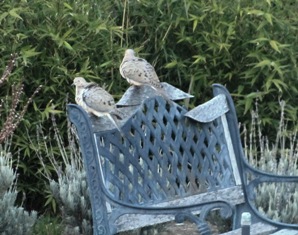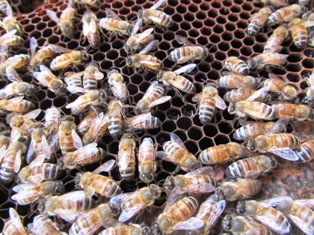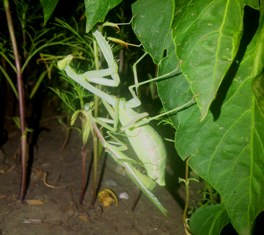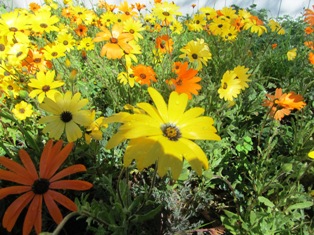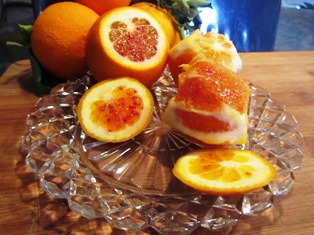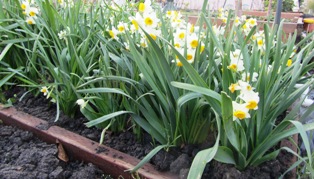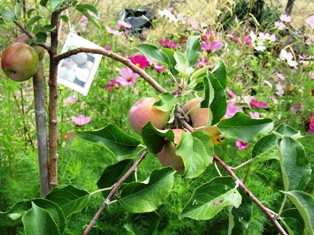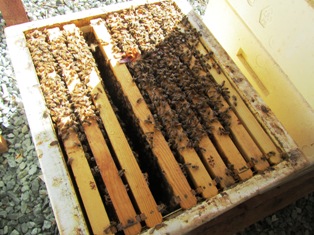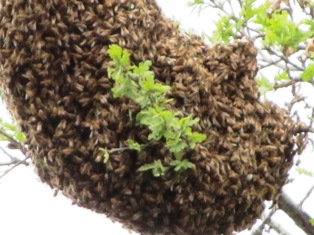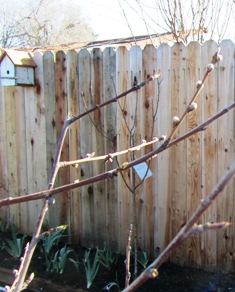Archive for February, 2013
A Whole Lot of Coupling Going On
Lately, the way the birds, insects, and wild creatures are pairing up, you’d think we were on Noah’s Ark instead of the Henny Penny Farmette.
I’ve never seen such bird and bee traffic as in the last few days. This morning, I put on the bee suit and joined my neighbor on a tour of inspection to see if the bees survived the cold snap we had a week or so ago. We had snow on Mount Diablo and a hard frost elsewhere. But the bees are fine, and there are lots of babies.
Today, the yellow finches are congregating around the Nyjer feeder and singing their little hearts out. There’s a woodpecker in the neighborhood (maybe two). I haven’t seen it/them but there’s a whole lot of tap-tap-tapping in the nearby oak trees.
I often see a flash of blue as I work to move and amend the soil on our property. Last year about this time, pair of Western blue birds were scouting locations for a nest. They are back and I hope they stick around.
The plaintive coo-coo-coo of the mourning doves has become a chorus of late. At first, I noticed a pair in the back yard and now there are several pairs. They mate for life. So we’ve put out birdseed and I fully expect to see a nest or two being constructed in the next few weeks.
Birds and bees are either producing young or making preparations to produce offspring. But the praying mantises? Who knew?
So what I’m taking from all this pairing up is that Mother Nature expects warm days ahead. The wild creatures made it through the winter. No one has to tell them what to do now that spring is only weeks away. Like I said, it looks like Noah’s Ark around here.
February Color on the Farmette
It’s difficult to find color in the dead of winter. It’s the last week of February and around the farmette it’s beginning to look like spring. Mixed in with the drab brown and gray and green are dazzling splashes of orange and yellow.
On Sunday, my husband and I helped out a neighbor with the pruning of her fruit and citrus trees. My husband will also be removing her aged trellis, cutting back the Japanese wisteria and reducing the size of what looks to be a 20-year-old grape vine.
She had two orange trees both loaded with oranges, so there was harvesting to be done before we could even start pruning back the tree. One was a Valencia orange, known as the juice orange. I cut into several of them this morning and found them streaked with red. What came to mind was that perhaps the busy little honeybees had cross pollinated her Valencia with a Blood Orange. I’m growing several on the farmette.
Citrus trees need little pruning. It’s easy to thin the shoots and branches, rather than shortening the tree. You can also revitalize an old tree that is unproductive (my neighbor’s tree was old but still producing a lot of fruit) by pruning a little more severely but such a severe pruning can stop fruiting for one to two years.
Growers say to feed citrus four times a year; I feed mine once a month with a deep watering. Soils that don’t have good organic matter and nitrogen will benefit from compost, blood meal, cottonseed meal, and well rotted manure on the soil surface out to the drip line. If your citrus isn’t performing for you, try scratching around the surface of the soil under the tree. This stresses the surface roots. Citrus need good drainage. Water slowly and deeply.
We’ve been lucky to have a stretch of warm, sunny days here in Northern California at the end of February. The fruit and nut trees have burst into bloom. Around the farmette, there are pink and white buds opening on the apple, apricot, peach, and almond trees.
The field in the back is knee-high with wild mustard and its blooms are bright yellow on green stalks. The yellow and orange daffodils and purple hyacinths create a floral motif on the drab winter cloak of Mother Nature . . . at least here on the Henny Penny Farmette. Just another reason why I love living here.
Growing Greens
Early spring on the Henny Penny Farmette offers the perfect amount of sunshine, cool weather, and rain that lettuce and salad greens love. Lettuce is a cool-season crop and bolts in the heat, going to seed in the hot days of summer. Of course, from bolting comes seeds that you can harvest, dry, and plant another day.
Lettuce doesn’t demand much space to it can be tucked in around your garden almost anywhere. It likes nitrogen-rich soil that drains well and also retains moisture–in short, a rich humus type of soil. Lettuce plants have rather shallow roots and is almost 90 percent water. That means it needs lots of water (but again, good drainage).
Romain and Butterhead (or Boston) lettuce leaves are rich in nutrients whereas iceberg lettuce (that has leaves that are crisp and formed like cabbage) is the least nutritious. It lacks the abundant amount of Vitamins A and B that are found in other cultivars of lettuce (and there are many).
Plant lettuce seeds 1/4 inch deep and space your rows 1 1/2 feet apart. Bear in mind, that you will get a lot of lettuce from a single seed pack–approximately 80 heads or 50 pounds of leaves in a 100-foot-long row.
Successive plantings over smaller amounts will enable you to have greens for salads and sandwiches right up to the warm days of summer. Even in summer, if you plant heat-resistant types of lettuce and plant them in the shade, giving them plenty of water, you can eat lettuce throughout the summer. Then in midsummer, plant head lettuces to harvest until the first frost.
Try growing some greens for fresh salads. Most lettuce will keep up to around ten days to two weeks in the refrigerator.
Blackberries and Dumplings
I dug up ensnarled blackberry vines yesterday and threw the lot into a bucket for replanting elsewhere on the farmette. Originally planted next to a fence, the vines had, over the last year, tangled into the roses and lavender that I had planted too near to them. Blackberry vines have a habit of spreading.
While cutting the vines, I recalled the blackberries and dumplings that my grandmother used to make in her small, but utilitarian farm kitchen near Booneville, Missouri.
We would set off in the early morning to gather the blackberries that grew in thickets around the farm. When our galvanized pails of berries grew heavy, we’d trudge back to the farmhouse.
My job was to wash the berries while my grandmother took a blue-striped yellow ware mixing bowl from the old Hoosier cabinet and began assembling the dry ingredients to make dumplings.
Dumpling ingredients:
1 cup all-purpose white flour
1 1/2 teaspoons baking powder
1/2 teaspoon salt
1/2 teaspoon baking soda
1 cup, plus 1 Tablespoon sugar
1 large egg (with yolk separated from egg white)
2/3 cup buttermilk
3 Tablespoons of butter (2T for dumpling batter, 1T for skillet)
Two pints of freshly washed blackberries
Directions for making the dumplings:
Combine flour, baking powder, salt, baking soda, and a Tablespoon of the sugar.
Mix together in another bowl the egg yolk, buttermilk, and 2 Tablespoons of butter.
Slowly combine the wet ingredients into the dry.
Beat the egg white until peaks rise and then fold it into the dumpling batter.
Directions for cooking:
In a 10-inch cast-iron skillet over medium high heat, melt 1 Tablespoon of butter. Using a large spoon, drop half dozen or so of the dumpling batter into the butter and cook about five minutes until both sides are brown. Remove this batch and repeat until all batter is cooked. Then set the dumplings aside.
Pour the blackberries into the skillet with 1 cup sugar. Mix together until the berries and sugar simmer and then reduce the heat. Position the dumplings on top of the blackberries and cook for ten minutes. The dessert is best served warm. Serves 4 to 6.
Daffodils
William Wordsworth wrote, “A host of golden daffodils; beside the lake, beneath the trees, Fluttering and dancing in the breeze.”
These fragrant flowers evoke for me memories of growing up in rural Missouri where every spring, bulbs, in repetition of an ancient cycle, pushed upward through the earth with swordlike precision and flowered.
I’ve plucked some of these beauties for my desk. If I must work indoors, then I will enjoy their lovely yellow blooms where they rest in a vase upon my desk, which otherwise is piled high with books. I work. And every once in a while, I capture a whiff of their sweet scent permeating the room.
The following is a list of of several types of daffodils:
Trumpet daffodils (these include the King Alfred, Unsurpassable, and Beersheba (the latter is a white whereas the former has yellow blooms).
Large-cupped daffodils (Carlton, Fortune, Gertie Millar, and Tunis).
Jonquilla Hybrids (Trevithian)
Triandrus Hybrids (Thalia)
Double daffodils (Mary Copeland, White Lion, Twink)
Small-cupped daffodils (April Showers, Mrs. Nette O’Melveny)
Cyclalmineus Hybrids (February Gold)
Poeticus narcissus (Actaea, white flowers, yellow cups, edged in red)
Plant them in the fall in a location where they won’t be moved as they will increase in number each year. There are a lot of reasons to like daffodils: they give your garden color in the spring, the tolerate heat and cold, they are unappetizing to golphers, and they soon naturalize in the landscape.
Grafting Expands Fruiting Options
Last year during bare-root season, I purchased a multi-variety tree offering several types of apples, including the Fuji pictured above as well as Einsheimer. Sometimes spelled as Ein Schemer, this apple variety comes from Israel and has low-chill requirements, unlike some apples that need many hours of chilling. It’s a good choice for southwestern U.S. and Northern California gardens.
Anna and Beverly Hills are the other two varieties grafted onto my multi-apple tree. Such trees are ideal if you have limited space and cannot plant more than one tree. Apple trees also look lovely espaliered against a wall.
Apples live longer than many of the deciduous fruit trees. They have short fruit spurs that can produce apples for up to 20 years. The only pruning required is to remove dead, weak, damaged or crossed branches and twigs.
A true dwarf apple won’t exceed 5 to 6 feet in width and height; a semi-dwarf, however, can easily reach 10 to 15 feet. Apples like deep soil but many will tolerate less-than-ideal soil; even soil with poor drainage or clumpy clay soil. Some apples are self-fruitful and others need a pollinizer (which might not be a problem if you have other pollinizing apple trees in your neighbor’s yards.)
I took a class years ago through University of California (Santa Cruz extension) to learn grafting. The process is not difficult to master. And the only tool you truly need is a sharp knife to cut a piece of stem (called a scion). The scion must have a couple of growth buds on it.
Stock is the plant you will graft the scion onto. For example, you might want to graft an Anna variety apple scion onto a Fuji apple tree (stock). You will cut the scion from the Anna and insert that scion into into the Fuji. Select a scion roughly the same diameter as the stock branch (you will graft the scion onto). The union (when the graft succeeds) is a new branch that carries the Anna apple.
The tricky part of grafting is aligning the cambium layer of the scion with the cambium layer of the stock. So how do you find the cambium. Simple. The cambium is the tissue-thin layer between the bark and the inner wood of the tree.
Cut the end of the scion into a wedge (like an ax edge or a two-sided tip of an arrow) and also make a cut into the branch of the stock. Then slide the tip of your scion into the stock, making sure that cambium aligns with cambium. I like to then bandage the grafting area to hold the scion in place until the graft has taken.
There are other ways to graft, but this one has worked best for me. For western gardeners, Sunset’s Western Garden Book has great illustrations and directions for grafting. Also the following website for the University of Minnesota provides easy-to-follow instructions. See, http://www.extension.umn.edu/distribution/horticulture/dg0532.html.
You increase your chances for success if you graft like varieties to each other and also if you do the grafting during the dormant season before buds start showing up and swelling. Grafting expands your options for multiple varieties of fruits on the trees in your garden. Just remember to graft varieties of scion and stock that are botanically similar.
Forcing Blooms of Branches and Bulbs
If spring hasn’t arrived in your corner of the world, be of good cheer. You can effectively bring spring indoors by forcing bulbs to open or branches of spring-flowering trees to bloom in your home.
Trees that bloom in the spring need to have sufficient chilling hours before they break their dormancy, so it’s advisable to try forcing blooms during the months of January and February rather than in December.
Choose half-inch branches of golden forsythia, pussy willow, coral quince, or almost any fruit tree. Using sharp pruning shears or a knife, cut diagonally above a bud so that you have two- or three-feet long branches to force into bloom.
After bringing the branches indoors, you’ll want to cut slits into the bottom of the branches to ensure water is more easily absorbed. Put the branches in a container of water. Every other day, trim the stems and change the water. Bring in new branches every few days to ensure continuous blooms.
Nothing beats the paper-white narcissus or buttery yellow daffodil for brightening a kitchen on a dreary winter’s day. Choose healthy a bulb (or bulbs) free of bruising, cuts, of infection. In a bowl, glass, or saucer, place glass marbles or pebbles. Add water.
Position the bulb or bulbs securely so that the roots can grow down into the water, but the bulb remains out of the water sitting on top of the marbles or pebbles. Ensure that the water level beneath the bulb remains constant and add more water as necessary.
Paper-white narcissus, purple hyacinth, and certain daffodils add not only spring color to an indoor environment but also a lovely sweet scent wherever they are placed.
Plants Bees Love
Last summer, I saved the seed from the flower heads plucked out of the gardens around the Henny Penny Farmette (cosmos, zinnia, marigold, nasturtium, and others). Now that the weather has turned warm (and rain is forecast next week), now might be good time to plant those seeds.
I also want to put in some other plants that bees love. People who do not like bees buzzing around can use the list as a reference for what NOT to plant.
Plant open-pollinating plants and avoid hybridized seed that does not have the high pollen content that is most beneficial to the bees. See, http://thehoneybeeconservancy.org/act-today-2/plant-a-bee-garden/
LIST OF PLANTS FOR YOUR BEE GARDEN
abelia, acacia, Arenaria verna, artimesia, aster, savocado
bee balm, buddleia
callistemon citrinius (the bottlebrush shrub), calendula, calluna, ceanothus, Choisya ternata, citrus (all kinds), clover, cosmos, cotoneaster, crataegus
echinacea, echium, erica, eriogonum, escallonia, eucalyptus
feijoa, foxglove
gleditsia
heteromeles, hosta
iceplant
ligustrum (privet), Lonicera japonica (honeysuckle), Lonicera hildebrandiana
murraya paniculata
phyla nodiflora,polygonum capitatum, pyracantha
rosmarinus officinalis (rosemary)
salvia (sage), snapdragon, sorbus aucuparia, syzgium
Teucrium chamaedrys, thyme, Trachelospermum jasminoides (star jasmine)
wild lilac, wisteria, witch hazel
zinnia
While you are busily putting into the garden the plants bees love, why not put out a saucer of water with some large rocks or pebbles for them to stand on while they are drinking? Yes, honeybees get thirsty, too.
The gardens that attract bees are often gorgeous because of all the pollinating the bees do. When you plant the flowers bees love because of high pollen content and provide water, you are not only helping your garden to flourish, you are helping the beleagured honeybees. Our planet needs them.
Bees: Upstairs, Downstairs
My neighbor’s honeybees, just like people, love the warm weather. They’ve been busily scouting out sources of pollen during this past week of springlike temperatures hovering in the upper 60s Farenheit on the Henny Penny Farmette.
I’ve put out a little pottery saucer, the size of a dinner plate, to hold a bit of water for the honeybees who are flocking to the feet of the little angel statue I placed in the center. The bees need something to stand on or they’ll drown. My beekeeper neighbor says wine bottle corks are great for giving the bees a support while they hover near the water to quench their thirst.
Bees, left undisturbed, will build a healthy and strong colony providing they have a food and water source and a a brood box or super in which to live. Of course, they could also take up residence in a hollow tree trunk or other wild place of their choosing. But supers are what beekeepers use.
As the colony grows, the bees will definitely need a super. During the summer months, adding a super on top of the brood box or other super gives the honeybees more room “upstairs.” There, they can store honey while “downstairs” the queen can lay more eggs in the cells of the brood box.
Seeing so much bee activity after a quiet winter, I’m ready to start planting annuals and perennial flowers with high pollen value that attract the bees. More food for the bees means more honey in the hive.
Growing Palate-Pleasing Peaches
In the orchard area of the Henny Penny Farmette, we’ve planted several fruiting peach trees. Today, during this first full week in February, the Desert Gold peach trees (Prunus persica) broke into bloom.
These trees are more tolerant of heat than some of the varieties, but if planted in the desert Southwest or even in the hot interior valleys of California, the peach trees will perform better if given a little afternoon shade.
There are basically four types of peach trees: fruiting, flowering, combination fruiting and flowering, and dwarf. All peaches require heat during the hot weather months of their growing cycle and won’t properly set many blooms or be well pollinated during springs that are cold and wet. These trees also need some chilling during the winter months when they drop their leaves and go dormant.
We’ve discovered that our peach trees benefit from regular feedings (I’ve used fish emulsion tea, manure tea, and even chicken manure worked into the soil around the base of the tree) two or three times a year. For mature trees, plan on cutting away 2/3 of the previous year’s growth or cut each branch back about 1/3 it’s total length.
The Internet has some great videos that demonstrate how to properly prune your peach trees.
If you’ve prune your peach tree properly, you’ll have lovely, large fruits. Another technique to increase fruit size is to thin the number of fruits on the tree. Taking away some of the smaller fruits and reducing the size of the crop means that the remaining fruit can enlarge before ripening.
Peach leaf curl, peach leaf borer, and scale insects are pesky problems for peach growers and gardeners. Treatment requires spraying with Bordeaux mixture or lime sulfur twice a year. Nurseries suggests you spray your peach trees in November and again just before the buds swell.
Now, our trees are ready to flower, be pollinated by the honeybees, and produce some luscious peaches by the end of May. I’ll use the ripe peaches to make some palate-pleasing jams.
 Facebook
Facebook Goodreads
Goodreads LinkedIn
LinkedIn Meera Lester
Meera Lester Twitter
Twitter




